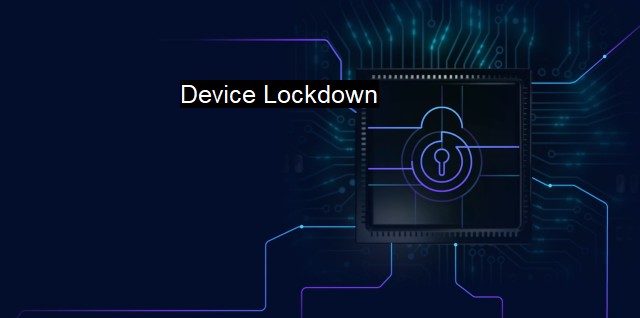What is Device Lockdown?
Enhancing Cybersecurity with Device Lockdown: A Comprehensive Guide for PCs, Tablets, and Smartphones
Device lockdown is a specific method used in cybersecurity strategies to limit unauthorized access and protect critical information from compromise. Within an ever-growing digital landscape, the threat prospect is completely unparalleled. Cybersecurity has shifted to become a colossal challenge for both organizations and individuals due to the rapid proliferation of smart devices. The "device lockdown" concept has become increasingly significant as a defensive measure, especially considering our over-dependence on a variety of smart and connected devices.In the context of cybersecurity and antivirus applications, "device lockdown" refers to safeguarding transitory or stored data on devices by implementing stringent access control. This restricts users' rights or actions on a device, preventing unauthorized users from installing, configuring, or tampering with the device's essential components or applications.
Device lockdown essentially covers stringent administrative controls that help limit users' functionality and enforce restrictions on various features such as peripheral device connection, internet accessibility, or usage of explicit software. The primary purpose of a device lockdown is to prevent security breaches that could stem from vulnerabilities present on the unsecured devices. By imposing strict controls and checks, they ensure the preservation of sensitive digital assets, thus fortifying the overall security posture.
Devices which usually undergo lockdown include computers, laptops, smartphones, tablets, point-of-sale systems, and specific industry-grade equipment. An ideal device lockdown strategy encapsulates an optimal mix of parameter settings and applications installed on a device, to isolate any software which can potentially inflict harm. These settings and applications can then police the system, ensuring only secure or authorized actions are permitted.
Often in an organization, the IT departments use a range of device lockdown methods to drastically reduce the risk of devices becoming points of entry into the network. In addition to restricting application usage and limiting internet access, there's also scope for device 'time lockdowns', which shut down device activity beyond working hours. Employee training is another crucial step to ensure everyone is aware of these restrictions and why they are in place.
Antivirus software is a key player in device lockdown procedures. It plays a vital role in devices' secure lockdown by continually scanning for potential malware or viruses, identifying suspicious activities, removing detected threats, and reporting the prevention measures. Modern antivirus engines incorporate real-time protection and application control features, ensuring secure file processing, isolation of harmful applications and maintaining integrity.
Certain types of antivirus additionally offer device lockdown features that are designed to restrict access to system functionalities or storage, which adds an extra layer of protection. For instance, some antivirus software permits strict lockdown of devices in case of lost or stolen scenarios. In such situations, a remote lockdown feature can help restrict physical access to the device, thus, preventing any unauthorized attempt to leak or manipulate affluent data.
Amid the influx of cyber threats and increased dependency on smart devices, device lockdown serves as an illuminated pillar in the realm of cybersecurity. Implementing a robust device lockdown strategy, reinforced with an adept antivirus solution, is a fundamental step towards constructing a comprehensive defense system. As we further delve into an era besieged by cyber vulnerabilities, it's evident that the device lockdown strategy continues to define the cybersecurity paradigm with goals of confidentiality, integrity, and availability moving to the forefront of strategic cybersecurity initiatives.

Device Lockdown FAQs
What is device lockdown?
Device lockdown refers to the practice of restricting access to certain features or applications on a device to prevent unauthorized use or exposure to security risks. In the context of cybersecurity and antivirus, device lockdown is a security measure used to protect devices from malware and other types of cyber threats.Why is device lockdown important for cybersecurity?
Device lockdown is important for cybersecurity because it prevents unauthorized access to sensitive data and applications on devices. By limiting the ability of users to install or use certain software, organizations can reduce the risk of malware infections and other cyber attacks. Device lockdown can also help prevent data breaches by limiting access to confidential information.What are some common examples of device lockdown measures?
There are several common examples of device lockdown measures, including whitelisting, blacklisting, and application control. Whitelisting involves allowing only approved applications to run on a device, while blacklisting involves blocking certain applications. Application control allows administrators to set policies that define which applications can be installed or used on a device. Other device lockdown measures may include disabling USB ports, restricting access to certain websites or networks, and limiting user privileges.How can I implement device lockdown on my devices?
Implementing device lockdown on your devices will depend on the specific tools and software you use. Some antivirus programs may offer device lockdown features as part of their security suite, while other organizations may use mobile device management (MDM) software to manage and secure devices. To implement device lockdown, you will typically need to identify which applications or features present security risks and set policies to restrict access or block them entirely. It is important to ensure that any device lockdown measures are properly configured and tested to avoid disrupting normal device functionality or causing other issues.| | A | | | B | | | C | | | D | | | E | | | F | | | G | | | H | | | I | | | J | | | K | | | L | | | M | |
| | N | | | O | | | P | | | Q | | | R | | | S | | | T | | | U | | | V | | | W | | | X | | | Y | | | Z | |
| | 1 | | | 2 | | | 3 | | | 4 | | | 7 | | | 8 | | |||||||